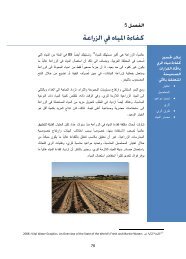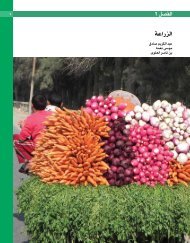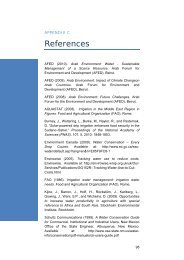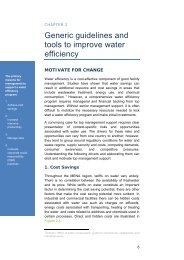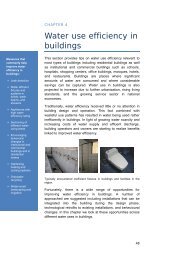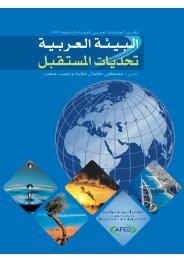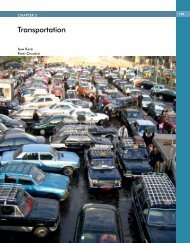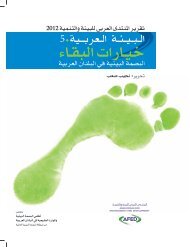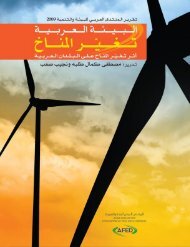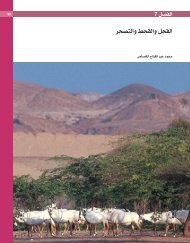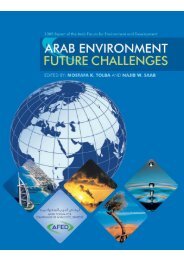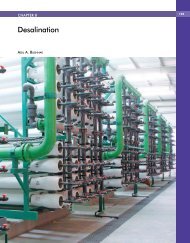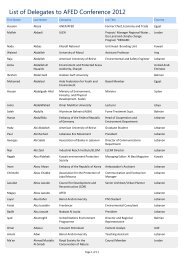Impact of Climate Change on Arab Countries - (IPCC) - Working ...
Impact of Climate Change on Arab Countries - (IPCC) - Working ...
Impact of Climate Change on Arab Countries - (IPCC) - Working ...
You also want an ePaper? Increase the reach of your titles
YUMPU automatically turns print PDFs into web optimized ePapers that Google loves.
ARAB ENVIRONMENT: CLIMATE CHANGE 39<br />
FIGURE 9<br />
LANDSAT SATELLITE IMAGES SHOW VAST COASTAL EROSION IN THE NILE DELTA<br />
WITH A RETREATING RATE OF UP TO 100 METERS PER YEAR IN SOME AREAS<br />
(CRS-BU, E. Gh<strong>on</strong>eim - AFED 2009 Report)<br />
Euphrates in Iraq. These locati<strong>on</strong>s are highly<br />
populated areas and am<strong>on</strong>g the most important<br />
agricultural lands in the regi<strong>on</strong>. As illustrated<br />
from the computed SLR (see Figure 1), these<br />
two areas are regi<strong>on</strong>ally the most vulnerable. In<br />
fact, impacts will be much bigger when combined<br />
with increase in the incidence <str<strong>on</strong>g>of</str<strong>on</strong>g> extreme<br />
events <strong>on</strong> low-level areas.<br />
The total area <str<strong>on</strong>g>of</str<strong>on</strong>g> Egypt is slightly over <strong>on</strong>e milli<strong>on</strong><br />
km, most <str<strong>on</strong>g>of</str<strong>on</strong>g> which has an arid and hyperarid<br />
climate. Roughly 94% <str<strong>on</strong>g>of</str<strong>on</strong>g> Egypt’s land mass<br />
is made up <str<strong>on</strong>g>of</str<strong>on</strong>g> desert. The fast growing populati<strong>on</strong>,<br />
now approaching about 81 milli<strong>on</strong>, inhabits<br />
less than 6% <str<strong>on</strong>g>of</str<strong>on</strong>g> the country’s land area. This<br />
land area, which is located in the Nile Delta and<br />
the Nile valley, c<strong>on</strong>tains the most productive<br />
agricultural land and hence the main food<br />
source for the entire country. The Nile Delta,<br />
which is about 24,900 km 2 in area, al<strong>on</strong>e<br />
accounts for about 65% <str<strong>on</strong>g>of</str<strong>on</strong>g> Egypt agricultural<br />
land. This delta, <strong>on</strong>ce the largest depocenter in<br />
the Mediterranean, is an extreme example <str<strong>on</strong>g>of</str<strong>on</strong>g> a<br />
flat low-lying area at high risk to SLR (El-Raey,<br />
1997). The delta is presently retreating due to<br />
accelerating erosi<strong>on</strong> al<strong>on</strong>g the coastline. This<br />
has generally been attributed to both human<br />
and natural factors. The c<strong>on</strong>structi<strong>on</strong> <str<strong>on</strong>g>of</str<strong>on</strong>g> the<br />
Aswan High Dam (1962) and the entrapment<br />
<str<strong>on</strong>g>of</str<strong>on</strong>g> a large amount <str<strong>on</strong>g>of</str<strong>on</strong>g> sediments behind it, in<br />
Lake Nasser, are major factors causing erosi<strong>on</strong><br />
in the Nile Delta. The entrapment <str<strong>on</strong>g>of</str<strong>on</strong>g> another<br />
c<strong>on</strong>siderable quantity <str<strong>on</strong>g>of</str<strong>on</strong>g> Nile sediments by the<br />
extremely dense network <str<strong>on</strong>g>of</str<strong>on</strong>g> irrigati<strong>on</strong> and<br />
drainage channels and in the wetland <str<strong>on</strong>g>of</str<strong>on</strong>g> the<br />
northern delta has also c<strong>on</strong>tributed greatly to<br />
the delta’s erosi<strong>on</strong> (Stanley, 1996). At present,<br />
<strong>on</strong>ly a little amount <str<strong>on</strong>g>of</str<strong>on</strong>g> the Nile River sediments<br />
is carried seaward to replenish the Nile Delta<br />
coast at its northern margin. Even the very<br />
small remaining amount <str<strong>on</strong>g>of</str<strong>on</strong>g> the delta sediment<br />
presently reaching the Mediterranean is<br />
removed by the str<strong>on</strong>g easterly sea currents.<br />
Moreover, the delta’s subsidence <str<strong>on</strong>g>of</str<strong>on</strong>g> about 1 to<br />
5 mm per year (Stanley, 2005), due to both natural<br />
causes and heavy groundwater extracti<strong>on</strong>, is<br />
influencing the coastal erosi<strong>on</strong> tremendously.<br />
Such coastal impact is evident in satellite<br />
images, where coastal erosi<strong>on</strong> can be clearly



